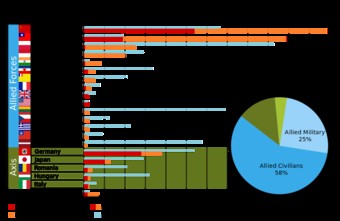World War II stands as the deadliest military conflict in history. Estimates indicate that approximately 75 million people perished, encompassing both military personnel and civilians. This staggering figure underscores the immense scale of human loss caused by the global conflict.
The immense death toll of World War II can be attributed to various factors beyond direct combat. Nazi Germany, under Adolf Hitler, orchestrated the Holocaust, a systematic genocide. Around 6 million Jews were murdered, alongside 2.7 million ethnic Poles, and an estimated 4 million individuals from other groups deemed “unworthy of life.” These victims included disabled and mentally ill people, Soviet prisoners of war, homosexuals, Freemasons, Jehovah’s Witnesses, and Romani people. Furthermore, the German war machine relied heavily on forced labor, with approximately 12 million people, primarily from Eastern Europe, enslaved in its war economy.
Beyond Nazi atrocities, the Soviet Union’s gulags, or labor camps, contributed significantly to the death toll. Citizens from occupied nations like Poland and Baltic states, as well as German prisoners of war and Soviet citizens suspected of Nazi collaboration, perished in these camps. A staggering 57% of the 5.7 million Soviet prisoners of war captured by the Germans died during the conflict, totaling 3.6 million deaths. Even Soviet ex-POWs and repatriated civilians faced suspicion and potential imprisonment in the Gulag system.
Japanese prisoner-of-war camps also exhibited appalling death rates, particularly those used as labor camps. The International Military Tribunal for the Far East documented a Western prisoner death rate of 27.1%, with American POW deaths reaching 37%. This was seven times higher than death rates in German and Italian POW camps. While tens of thousands of prisoners from the UK, Netherlands, and the USA were released after Japan’s surrender, the number of released Chinese prisoners was minimal.
Forced labor under Japanese occupation extended to civilians as well. Historian Zhifen Ju estimates that at least five million Chinese civilians were enslaved by the Kōain (East Asia Development Board) between 1935 and 1941, with numbers reaching 10 million after 1942. These individuals were forced to work in mines and war industries. In Java, estimates from the US Library of Congress suggest that 4 to 10 million rōmusha (manual laborers) were coerced into service by the Japanese military. A significant number of these Javanese laborers were sent to other Japanese-controlled territories in Southeast Asia, with a small fraction ever returning home.
Internment policies also contributed to suffering, although not directly to the overall death count in the same way as genocide and forced labor. The internment of approximately 100,000 Japanese Americans in the US and similar programs in Canada, along with the internment of German and Italian citizens deemed security risks, represent a dark chapter of wartime policies. Furthermore, post-war agreements led to millions of POWs and civilians being used as forced labor by the Soviet Union, with some groups, like Hungarians, enduring this forced labor until 1955.
In conclusion, determining the precise number of deaths in WWII remains a complex and somber task. The estimated 75 million deaths represent a devastating human catastrophe resulting from combat, genocide, forced labor, and inhumane treatment. Understanding the scale and multifaceted nature of these losses is crucial for remembering the profound impact of World War II and working towards a more peaceful future.
